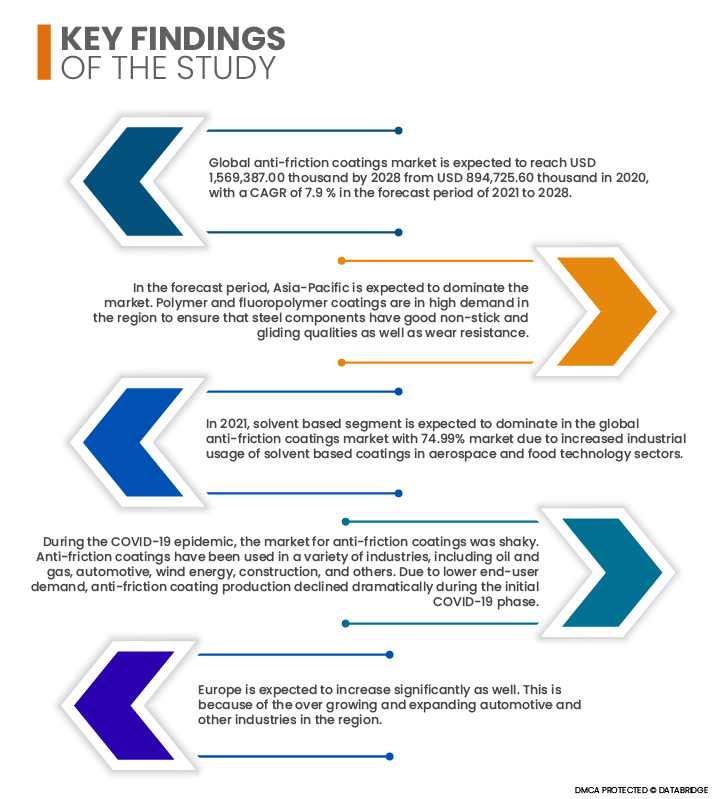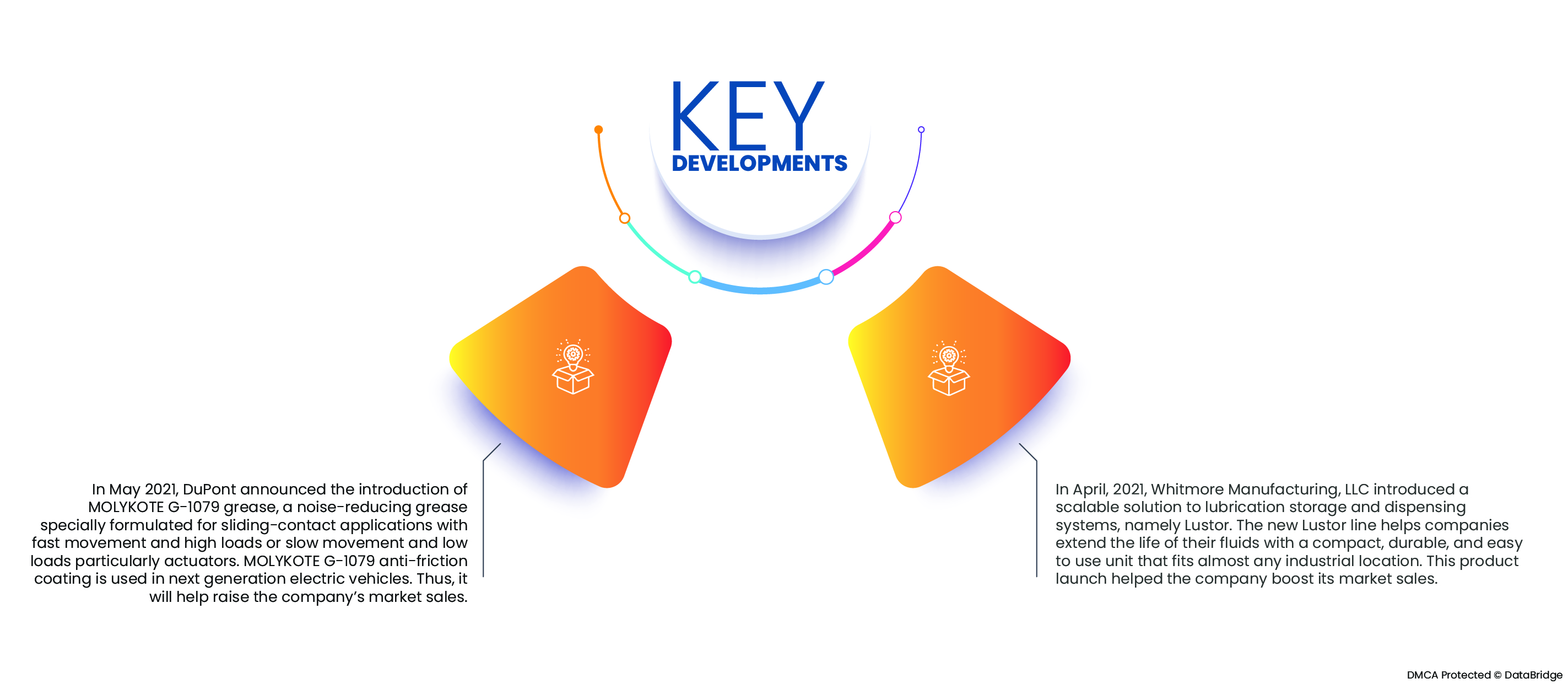저마찰 코팅은 내열성, 내화학성 또는 클린룸 환경이 요구되는 작업 환경에서 습윤 윤활제 사용을 최소화하는 동시에 성능과 서비스 수명을 향상시킵니다. 저마찰 코팅은 입자가 카운터 표면에 달라붙거나 흡착될 가능성을 줄여 세척 시간을 단축합니다. 결과적으로 공구 개발 과정에서 점착 방지 화합물의 사용량을 줄일 수 있습니다. 저마찰 코팅은 최근 습윤성, 내식성, 접착력, 내마모성 등의 표면 품질을 향상시키기 위해 점점 더 널리 사용되고 있습니다.
글로벌 마찰 방지 코팅 시장은 2020년 8억 9,472만 5,600달러에서 2028년까지 1,569,387.00달러로 성장할 것으로 예상되며, 2021년부터 2028년까지 연평균 성장률은 7.9%입니다. 습윤성, 내식성, 접착력, 내마모성과 같은 표면 품질을 개선할 수 있는 잠재력으로 인해 저마찰 코팅은 최근 몇 년 동안 점점 더 인기를 얻고 있습니다. 다양한 산업 분야에서 저마찰 코팅 사용이 확대됨에 따라 가까운 미래에 시장 확장이 가속화될 것으로 예상됩니다. 또한, 저마찰 코팅 제조업체는 특정 용도 제품에 대한 수요 증가를 충족하기 위해 새로운 솔루션을 개발하고 있습니다. 윤활제 사용에 대한 환경 규제가 강화되고 폐기 비용이 증가함에 따라 표면이 서로 마찰되고 마모가 줄어들도록 하는 저마찰 박막 코팅이 점점 더 인기를 얻고 있습니다.

산업용 애플리케이션에 대한 수요 증가로 시장 성장률이 높아질 것입니다.
마찰 방지 코팅은 일반 산업용 페인트와 유사한 제형을 가진 윤활 용액의 한 종류입니다. 고체 윤활제와 용매인 수지로 구성됩니다. 고체 윤활제의 주요 성분은 이황화몰리브덴, 폴리테트라플루오로에틸렌(PTFE), 그리고 흑연입니다. 이러한 코팅은 자동차 산업에서 건식 윤활제로도 사용됩니다. 이러한 특성이 시장 성장을 견인하고 있습니다. 공공 및 민간 부문의 인프라 개발 지출 증가 또한 시장 성장을 촉진할 것입니다. 첨단 기술 도입과 관련된 지속적인 연구 개발은 시장 성장의 폭을 다시 한번 확대할 것입니다.
보고서 범위 및 시장 세분화
보고서 메트릭
|
세부
|
예측 기간
|
2021년부터 2028년까지
|
기준 연도
|
2020
|
역사적인 해
|
2019 (2013~2018년으로 맞춤 설정 가능)
|
양적 단위
|
매출(USD 천), 볼륨(단위), 가격(USD)
|
다루는 세그먼트
|
제품(MOS2, PTFE, 흑연, FEP, PFA 및 이황화텅스텐) 특성(용매 기반 및 수성) 응용 분야(자동차 부품, 동력 전달 품목, 베어링, 탄약 구성 요소, 밸브 구성 요소 및 액추에이터 및 기타) 최종 사용(자동차, 항공우주, 해양, 건설, 의료 및 기타)
|
포함 국가
|
미국, 북미의 캐나다 및 멕시코, 독일, 프랑스, 영국, 네덜란드, 스위스, 벨기에, 러시아, 이탈리아, 스페인, 터키, 유럽의 기타 유럽 국가, 중국, 일본, 인도, 한국, 싱가포르, 말레이시아, 호주, 태국, 인도네시아, 필리핀, 아시아 태평양(APAC)의 기타 아시아 태평양(APAC), 사우디아라비아, UAE, 남아프리카 공화국, 이집트, 이스라엘, 중동 및 아프리카(MEA)의 일부인 기타 중동 및 아프리카(MEA), 남미의 일부인 기타 남미 국가.
|
시장 참여자 포함
|
DuPont(미국), Parker Hannifin Corp(미국), CARL BECHEM GMBH(미국), ASV Mutichemie Private Limited(인도), Whitmore Manufacturing LLC.(독일) 등이 있습니다.
|
보고서에서 다루는 데이터 포인트
|
Data Bridge Market Research 팀이 큐레이팅한 시장 보고서에는 시장 가치, 성장률, 시장 부문, 지리적 범위, 시장 참여자, 시장 시나리오와 같은 시장 통찰력 외에도 심층적인 전문가 분석, 환자 역학, 파이프라인 분석, 가격 분석, 규제 프레임워크가 포함되어 있습니다.
|
세그먼트 분석:
글로벌 마찰 방지 코팅 시장은 제품, 특성, 응용 분야 및 시장에서의 최종 용도를 기준으로 4가지 주요 부문으로 구분됩니다.
- 제품 기준으로 전 세계 마찰 방지 코팅 시장은 MOS2, PTFE, 흑연, FEP, PFA, 그리고 텅스텐 시둘파이드로 구분됩니다. 2021년에는 MOS2 부문이 자동차 산업에서 엔진 내부 부품용 코팅으로 MOS2 코팅 사용이 증가함에 따라 24.67%의 시장 점유율을 기록하며 전 세계 마찰 방지 코팅 시장을 주도할 것으로 예상됩니다. 아시아 태평양 지역에서는 자동차 산업에서 윤활유로 MOS2 기반 코팅 사용이 증가함에 따라 중국과 인도에서 MOS2 기반 코팅 수요가 더 높습니다.
- 코팅의 특성에 따라 전 세계 마찰 방지 코팅 시장은 용제형과 수성형으로 구분됩니다. 2021년에는 용제형 코팅이 항공우주 및 식품 기술 분야에서 용제형 코팅의 산업적 사용 증가로 전 세계 마찰 방지 코팅 시장의 74.99%를 차지하며 시장을 주도할 것으로 예상됩니다. 아시아 태평양 지역에서는 자동차 산업에서 용제형 코팅의 사용량이 높은 중국과 인도를 중심으로 용제형 코팅 수요가 증가하고 있습니다.
용매 기반 세그먼트는 코팅 시장의 본질적인 코팅 세그먼트의 본질을 지배할 것입니다.
용제 기반 부문은 2021년 코팅 시장에서 가장 큰 비중을 차지하는 부문으로 부상할 것입니다. 이는 특히 개발도상국에서 직접 입찰이 증가하고 있기 때문입니다. 또한, 전 세계 최종 사용자 산업의 성장과 확장은 이 부문의 성장을 더욱 가속화할 것입니다.
- 글로벌 마찰 방지 코팅 시장은 적용 분야별로 자동차 부품, 동력 전달 장치, 베어링, 탄약 부품, 밸브 부품 및 액추에이터 등으로 구분됩니다. 2021년에는 자동차 부품 부문이 부식, 소음, 건식 윤활 등을 방지하기 위해 자동차 산업에서 마찰 방지 코팅 적용이 증가함에 따라 36.81%의 시장 점유율을 기록하며 글로벌 마찰 방지 코팅 시장을 주도할 것으로 예상됩니다. 아시아 태평양 지역 자동차 시장은 자동차 산업에서 마찰 방지 코팅 사용 증가로 인해 중국과 인도를 중심으로 시장 점유율이 크게 확대되고 있습니다.
- 최종 사용자 기준으로 글로벌 마찰 방지 코팅 시장은 자동차, 항공우주, 해양, 건설, 의료 등으로 세분화될 수 있습니다. 2021년에는 자동차 부문이 차량의 소음 및 진동 감소를 위한 마찰 방지 코팅 사용 증가로 34.98%의 시장 점유율을 기록하며 글로벌 마찰 방지 코팅 시장을 주도할 것으로 예상됩니다. 아시아 태평양 지역에서는 자동차 부품의 보호 코팅으로 마찰 방지 코팅이 사용되면서 자동차 부문의 수요가 꾸준히 증가하고 있습니다. 유럽에서는 전기 자동차 생산에 마찰 방지 코팅이 사용됨에 따라 자동차 부문의 마찰 방지 코팅 수요가 급증하고 있습니다.
자동차 부문은 보호 장갑 시장의 최종 사용자 부문을 지배할 것입니다.
자동차는 2021년 약 35%의 시장 점유율을 기록하며 유통 채널에서 가장 큰 비중을 차지하는 부문으로 부상할 것으로 예상됩니다. 이는 특히 개발도상국에서 병원 수가 증가하고 있기 때문입니다. 또한, 전 세계적으로 자동차 산업의 성장과 확장은 이 부문의 성장을 더욱 가속화할 것입니다.
주요 플레이어
Data Bridge Market Research는 다음 회사를 보호 장갑 시장의 시장 참여자로 인식합니다: Semperit AG Holding(오스트리아), Supermax Corporation Berhad.(말레이시아), YTY Group.(말레이시아), Arista Networks, Inc.(미국), Kossan Rubber Industries Bhd(말레이시아), JIANGSU JAYSUN GLOVE CO.,LTD(중국), Bluesail Medical Co., Ltd.(중국), Shandong Yuyuan Latex Gloves Co., Ltd.(중국), Zhanjiang Jiali Glove Products Co.,Ltd.(중국), Top Glove Corporation Bhd(말레이시아), Hartalega Holdings Berhad(말레이시아), Robinson Healthcare(영국), SHIELD Scientific BV(네덜란드), PAUL HARTMANN AG(독일).

시장 개발
- 2021년 5월, 듀폰은 MOLYKOTE G-1079 그리스 출시를 발표했습니다. 이 그리스는 빠른 움직임과 높은 하중, 또는 느린 움직임과 낮은 하중, 특히 액추에이터와 같은 슬라이딩 접촉 애플리케이션에 적합하도록 특별히 제조된 소음 감소 그리스입니다. MOLYKOTE G-1079 마찰 방지 코팅은 차세대 전기 자동차에 사용되어 회사의 시장 매출 증대에 기여할 것입니다.
- 2021년 4월, Whitmore Manufacturing, LLC는 윤활유 저장 및 분배 시스템에 확장 가능한 솔루션인 Lustor를 출시했습니다. 새로운 Lustor 제품군은 거의 모든 산업 현장에 적합한 작고 내구성이 뛰어나며 사용하기 쉬운 제품으로, 기업들이 윤활유의 수명을 연장할 수 있도록 지원합니다. 이 제품 출시는 회사의 시장 매출 증대에 기여했습니다.
지역 분석
지리적으로 보호 장갑 시장 보고서에서 다루는 국가는 북미의 미국, 캐나다 및 멕시코, 유럽의 독일, 프랑스, 영국, 네덜란드, 스위스, 벨기에, 러시아, 이탈리아, 스페인, 터키, 유럽의 기타 유럽, 중국, 일본, 인도, 한국, 싱가포르, 말레이시아, 호주, 태국, 인도네시아, 필리핀, 아시아 태평양(APAC)의 기타 아시아 태평양(APAC), 사우디 아라비아, UAE, 남아프리카 공화국, 이집트, 이스라엘, 중동 및 아프리카(MEA)의 일부인 기타 중동 및 아프리카(MEA), 남미의 일부인 기타 남미입니다.
Data Bridge Market Research 분석에 따르면:
아시아 태평양 지역은 2021년부터 2028년까지의 예측 기간 동안 보호 장갑 시장 에서 지배적인 지역입니다.
예측 기간 동안 아시아 태평양 지역이 시장을 주도할 것으로 예상됩니다. 이 지역에서는 강철 부품의 우수한 논스틱 및 글라이딩 성능과 내마모성을 보장하기 위해 폴리머 및 불소폴리머 코팅에 대한 수요가 높습니다. 마찰 방지 코팅은 주로 자동차 분야의 분석 응용 분야에 사용됩니다. 건설, 의료 공학, 태양광 공학, 가구 산업, 풍력 에너지 공학 등에서 이러한 유형의 코팅을 사용하고 있습니다. 건설 부문은 지속적인 경제 발전을 위해 마찰 방지 코팅 분야에서 중요한 역할을 합니다. 국가통계국에 따르면 2020년 중국 GDP에서 건축 생산액이 차지하는 비중은 2019년 6.2%에서 25.9%로 증가했습니다.
유럽은 2021년부터 2028년까지 보호 장갑 시장 에서 가장 빠르게 성장하는 지역으로 추정됩니다.
유럽은 급속한 산업화로 인해 매력적인 성장 기회를 제공할 것으로 예상됩니다. 운송 및 자동차와 같은 최종 사용 부문에서 저마찰 코팅 수요가 증가함에 따라 유럽의 저마찰 코팅 수요도 증가할 것으로 예상됩니다. 유럽의 선진국 경제는 향후 몇 년 동안 크게 성장할 것으로 예상됩니다.
COVID-19 영향 분석
코로나19 팬데믹 기간 동안 마찰 방지 코팅 시장은 불안정했습니다. 마찰 방지 코팅은 석유 및 가스, 자동차, 풍력 에너지, 건설 등 다양한 산업에서 사용되어 왔습니다. 최종 사용자 수요 감소로 인해 코로나19 초기 단계에서 마찰 방지 코팅 생산량이 급격히 감소했습니다. 중국자동차공업협회에 따르면 중국의 자동차 판매량은 전년 대비 11.9% 감소한 186만 대를 기록했습니다. 더욱이 석유 및 가스 탐사 및 생산 산업은 2020년까지 1조 달러의 매출 손실을 예상합니다. 2020년 이들 국가의 풍력 에너지 설비 또한 전년 대비 30% 감소했습니다.
보호 장갑 시장 보고서 에 대한 자세한 내용은 여기를 클릭하세요 - https://www.databridgemarketresearch.com/reports/global-anti-friction-coating-market










